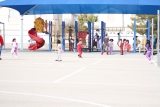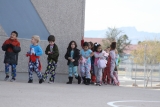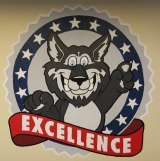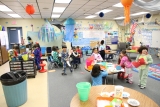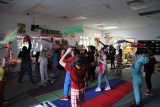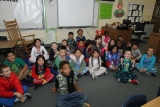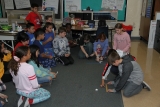-
Category 2
Selected in 2019
-
Grades: pre k - 5
School Setting: urban
Town Population: 642,000
Student Enrollment: 571
Student Demographics:
Black/African American: 11.6%
Teacher/Student Ratio: 1:25
White/Caucasian: 30%
Hispanic: 37.3%
Hawaiian/Pacific Islander: 4%
Asian: 7.2%
Native American: 0.4%
Other: 9.6%
% Reduced Lunch: 100%
% ELL Learners: 14%
Founded: 1990 -
PRINCIPAL:
Jennifer Reynolds -
CONTACT:
560 East Eldorado Lane
Las Vegas, NV 89123
702-799-5720
reynojl@nv.ccsd.net
Charlotte Hill Elementary School
Las Vegas, NV
We must educate and meet the needs of the whole child.
- Describe specific programs in place to ensure that families are involved in the success of your school and students.
-
Families play an integral role in ensuring the success of their children. We strive to provide consistent parent communication that involves and informs our families. Parent communication consists of emails, flyers, personal calls, conferences and parent workshops.
Early reading programs like Race to Read reinforce basic phonics skills for incoming kindergarten students. At the beginning of each school year, parents attend a training and are provided materials on how to work with their child at home.
We realize that all stakeholders play an essential role in shaping our students’ academic futures. For this reason, entities such as our Parent Teacher Organization and the School Organization Team exist. Parents and community members are able to voice their opinions and make important decisions regarding safety, funding, educational resources, and school events. In doing so, we provide the tools and strategies necessary to foster the academic progress of each student.
- Describe the most successful activity your school has initiated to strengthen ties to your community.
- Strengthening ties in our community cannot be attributed to one single function, but rather a variety of purposeful events. To meet our community’s diverse needs, we partner with a host of entities such as FACES, Foster Kinship, Ameriprise, ResortCom, EyeCare for Kids, and ThreeSquare, to name a few. These important organizations provide our families the opportunities to connect with each other and their surrounding community. Our community partners help facilitate and sponsor activities and provide much needed services, human capital, and donations.
- Describe your philosophy of school change or improvement.
-
The leadership team recognizes that both teachers and students develop at a unique pace. Therefore, leveraging the strength of each teacher is how the process of growth and change begins. PLC meetings and professional development provide a forum for analysis and reflection. Teachers learn from one another by embracing a school-wide collaborative learning community. In doing so, teachers rely on each other’s expertise and, in turn, distribute academic responsibilities equally.
We cultivate student learning by providing instruction that promotes both character development and academic success. In addition to providing strong Tier I instruction, social emotional lessons are created and taught by the Counseling Department. These lessons teach students to problem solve and take ownership for their learning.
- What are your school’s top two goals for the next year?
-
We will continue to close the achievement gap for all students by implementing weekly Professional Learning Community (PLC) meetings. Highly impactful instructional practices, data talks, and next steps planning will be the main focus of these meetings.
Charlotte Hill Elementary School also recognizes that vertical alignment has a direct impact on overall student achievement. Teachers will be given time to plan vertically to identify common key standards and curricular overlaps. Pacing guide adjustments will be made accordingly.
This year teachers will continue to participate in professional development sessions focusing on best practices in Tier I instruction, with specific emphasis on close reading of complex text. Finally, administration and teachers will have an opportunity to reflect on teaching practices via classroom observations.
- What is the single most important factor in the success of your school that others could replicate?
- Developing a teacher's practice is key to any school's and district's success. At Hill Elementary, leadership offers multiple opportunities for teachers to grow. This comes in the form of researched based strategy training sessions, grade-level and across grade-level collaboration time, data talks, and PLC meetings. When a community of teacher work together collectively, academic growth happens.
- Describe the program or initiative that has had the greatest positive effect on student achievement, including closing achievement or opportunity gaps, if applicable.
- Our school’s academic focus connects informational reading to writing. Therefore, Student Learning Goal (SLG) plans for all grade levels align to reading information standards, RI.1 and RI.2 and writing standards, W.2.b and W.2.c. During PLC meetings, teachers analyze data in reading and writing to determine if students are progressing toward their reading and writing goals set at the beginning of the school year. Adjustments to instruction are made accordingly throughout the year to ensure academic growth. Teachers and administration work collaboratively to identify supports and resources in the form of release time, professional development, and materials to ensure academic achievement for all students.
- Explain how ESEA federal funds are used to support your improvement efforts.
- In order to support improvement in student achievement, Charlotte Hill Elementary School chose to leverage its funding to pay for a Class Size Reduction (CSR) teacher in fourth grade. As a result, we were able to lower the average class size from 31 students to 27 students, a 13% reduction. Moreover, to support the diverse social-emotional and academic needs of our students, funds were allocated to pay for two full-time counselors. Funds were also used to hire two Certified Temporary Tutors (CTT) to provide small group instruction for students approaching proficiency. Students meet with CTTs twice a week to work on targeted skills. Finally, to encourage blended learning, we purchased computer-based programs aligned to standards in math and language arts. To facilitate blended learning in all classrooms, additional technology was purchased in the form of Chromebooks and headphones.
- Identify the critical professional development activities you use to improve teaching and student learning.
- We understand that in order to close the achievement gap for all students, Tier I instruction needs to be challenging enough to prepare our students for academic success in future grades. As a result, professional trainings focus on highly impactful practices such as standards-based writing, close reading strategies, professional book studies, data talks, and student-to-student discourse. Teachers are provided opportunities to observe new strategies through classroom observations and grow in their practice as they engage in the on-going cycle of inquiry.
- Describe how data is used to improve student achievement and inform decision making.
-
Teachers use formative assessment data such as MAP Growth, Ready, STAR, and writing to plan, deliver, and reflect on Tier I instruction. During PLC meetings, teachers reflect on the impact of their instruction, work collaboratively to plan next steps, and share best practices. Based on the data, adjustments are made to grade level pacing guides.
The Counseling Department utilizes attendance data to develop programs which target students identified as chronically absent. In addition, counselors monitor the types of referrals received to determine behavioral, social-emotional, academic, and attendance needs. This student-centered approach has led to a 29% decrease in bullying incidents and a 64% reduction in suspensions. Less time out of the classroom equals student achievement.
- Describe your school culture and explain changes you’ve taken to improve it.
- The culture of our school is centered around the belief that we must educate and meet the needs of the whole child. Understanding and meeting the social-emotional needs of students allows us to increase their potential to learn in a safe and supportive environment. The first change we made was creating a second counseling position to meet the American School Counselors Association (ASCA) recommendations. The counseling department delivers classroom lessons which empower our students to advocate for themselves in academic and social situations. In addition, we have daily announcements that are delivered by one of our counselors. Morning announcements are embedded with a weekly social skill and motivational quote. Classroom teachers reinforce weekly social skills to promote our school culture.
Stats
-
Category 2
Selected in 2019
-
Grades: pre k - 5
School Setting: urban
Town Population: 642,000
Student Enrollment: 571
Student Demographics:
Black/African American: 11.6%
Teacher/Student Ratio: 1:25
White/Caucasian: 30%
Hispanic: 37.3%
Hawaiian/Pacific Islander: 4%
Asian: 7.2%
Native American: 0.4%
Other: 9.6%
% Reduced Lunch: 100%
% ELL Learners: 14%
Founded: 1990 -
PRINCIPAL:
Jennifer Reynolds -
CONTACT:
560 East Eldorado Lane
Las Vegas, NV 89123
702-799-5720
reynojl@nv.ccsd.net


